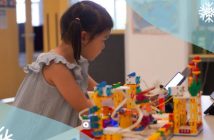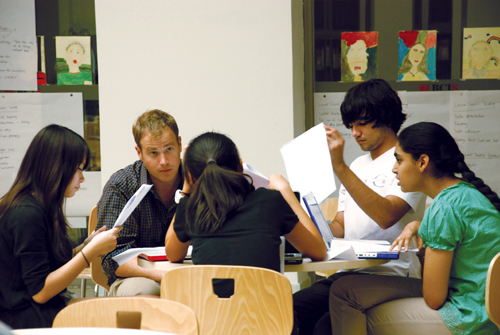
AP, ACT, the SAT
Both the Advanced Placement (AP) program and the SAT Reasoning Test (commonly known as the SAT) are administered by The College Board, an educational association based in the US.
The AP program is a high school curriculum that offers standardized courses generally considered to be the equivalent of undergraduate university courses. Students can earn credits towards their university education, giving them time to take higher level courses, pursue a double major, or study abroad.
The SAT is an internationally-recognized university admission exam. Most students take the SAT in their junior or senior year of high school. Most universities in the US will base their selections to a certain extent on SAT scores.
The ACT is another standardized test for university admissions. Administered by ACT , Inc., it was created in 1959 as a competitor to the SAT. In 2009, 45 percent of high school students took the ACT test.
Famous alumni: There are thousands of websites reporting the SAT scores of famous people like Microsoft co-founders Bill Gates (1590) and Paul Allen (a perfect 1600), horror writer Stephen King (1300), and former president George W. Bush (1206). These scores reflect the old SAT system, which carried a maximum possible grade of 1600.
Who does it target? AP courses, the ACT, and the SAT are generally taken by Grade 11-12 students (16-18 years old).
How is it applied? The College Board offers a total of 34 AP subjects. Some of the most popular courses include AP US History, AP English Literature, and AP Calculus AB. International schools in Beijing vary widely in the number of AP subjects they offer. The International Academy of Beijing offers only AP Calculus, while the International School of Beijing offers four AP classes.
AP students receive two grades: one for AP coursework and another for the AP exam. AP tests are taken in May and graded on a scale of 1 to 5 (5 being the highest). The multiple choice section is scored by a computer, while the free response and essay components are graded by AP readers. Though it varies from institution to institution, most universities require that students obtain a minimum grade of 3 or 4 to qualify for college credit. The tests are graded by The College Board, but students also have access to third-party test verification services for extra integrity.
As for the SAT test, it lasts over three hours and is divided into three sections: critical reading, writing, and math. Each section is made up of multiple choice questions, but the writing portion also requires students to compose a short essay. As of 2005, the SAT has a maximum possible score of 2400 (800 per section).
The ACT lasts four hours and includes four parts: English, math, reading, and science reasoning. (The optional ACT writing test adds 30 minutes to the exam time.) Scored out of a maximum 36 points, ACT questions are generally considered to be easier than the SAT’s, but the relatively limited time allotted to each section evens out the overall level of difficulty.
Why should parents consider it? High achievers are usually recommended for the AP program by their teachers. Because AP classes are so rigorous, students should only take as many as they can comfortably handle. It’s a way for them to challenge themselves and show prospective colleges that they are serious about academics. As for the SAT and ACT, it’s usually a good idea for students to take either test if they are interested in attending a university in the US.
Where is it offered?
Beijing Biss International School (BISS ): SAT test center
Beijing City International School (BCIS ): Offers SAT prep
Beijing Shuren-Ribet Private School (BSRPS): Is an ACT/SAT test center
International Academy of Beijing (IAB): Offers AP Calculus and is an SAT/ACT test center
International School of Beijing (ISB): Offers four AP courses and is an SAT/ACT test center
St. Paul American School (SPAS): Offers five AP courses and offers SAT prep
The Learning Center (TLC): Offers SAT prep
How well does this education system prepare students for the real world? Standardized tests like the ACT and SAT measure skills that are crucial to academic success in university. They assess how well students analyze and problem-solve – skills that are expected to acquire in high school. Most universities in the US will look at SAT/ACT scores and AP courses as part of the selection process. Outside the US, universities in over 60 countries recognize AP exam scores for admission or college credit. Some universities outside of the US will also consider SAT scores to assess students who didn’t complete the IB Diploma Programme.
 English National Curriculum
English National Curriculum
The English National Curriculum was developed by the British government for standard use in England, Wales, and Northern Ireland. It is used in over 30,000 schools in the UK and overseas. This education system is characterized by a broad, well-rounded education that narrows in focus by the time students reach Year 11.
Famous alumni: David Cameron (UK prime minister), Kazuo Ishiguro (novelist), Emma Watson (actress)
Who does it target?
The English National Curriculum targets students 3-18 years of age. They are divided into Key Stages that cover both primary and secondary school:
Key Stage 0: Ages 3-5 (also known as Early Years)
Key Stage 1: Ages 5-7 (Year 1-2)
Key Stage 2: Ages 7-11 (Year 3-6)
Key Stage 3: Ages 11-14 (Year 7-9)
Key Stage 4: Ages 14-16 (Year 10-11)
Key Stage 5: Ages 16-18 (Year 12-13)
How is it applied? Primary school students are assessed at the end of Key Stages 1 to 3 on a scale of 1 to 8 according to National Curriculum standards. These evaluations are based on both tests and teacher assessments, and are commonly known as “SATs” or Standard Assessment Tasks (not to be confused with the American SAT).
At the end of Year 11, students can sit up to ten subjects at a series of national exams known as the GCSEs (General Certificate of Secondary Education).
During Key Stage 5, students take the GCE Advanced Level exams, commonly known as A-levels. A-levels are a graduated system composed of AS levels (taken at the end of Year 12) and A2 levels (taken at the end of Year 13). Students cannot move on to A2 levels if they fail their AS exams. Universities in the UK will usually ask for at least three A-levels, with some requiring a fourth AS subject.
Why should parents consider it? A-levels give students the freedom to choose their areas of study and focus on their strengths. For example, an honor student who is working towards a scholarship in biology might not want to devote much time to the arts.
Where is it offered?
Beijing Rego British School (BRBS ): Complete curriculum
The British School of Beijing (BSB ): Complete curriculum
Dulwich College Beijing: Up to Year 9
Harrow International School Beijing: Complete curriculum
Wellington College International Tianjin: Complete curriculum
Yew Chung International School of Beijing (YCIS Beijing): Up to Year 11
How well does this education system prepare students for the real world? The British education system is well-recognized and accepted all over the world. A-levels are the standard qualification for universities in the UK, and help students focus on preferred subjects before applying to university. In addition, A-levels are generally accepted in the US and Europe, as well as former Commonwealth countries like Canada and Australia.

International Baccalaureate (IB)
Formerly known as the IBO , the International Baccalaureate (IB ) is a non-profit educational foundation headquartered in Geneva, Switzerland. It was founded in 1968 and is administered by a board of governors and six permanent committees that handle policy and best governance practices.
The IB is divided into three programs that can be applied individually or as a whole: the Primary Years Programme or PYP (ages 3-12), the Middle Years Programme or MYP (ages 11-16), and the Diploma Programme or IBDP (ages 16-19). Institutions that are authorized to offer one or more of these programs are known as IB World Schools. According to the IB’s official website, there are over 976,000 students studying at 3,295 IB World Schools in 141 countries around the world.
Famous alumni: Julie Payette (astronaut), Gael García Bernal (actor), Karen Mok (actress and singer)
Who does it target? As a whole, the IB’s programs target students 3-19 years of age.
How is it applied?
All of the IB’s programs share the following traits:
They require study across a broad range of subjects.
They emphasize language learning.
They encourage interdisciplinary learning.
They include a community service requirement.
Each of the IB’s programs has its own curriculum, but IBDP is the most well-known among them. Over two years, students study six subjects drawn from the following six subject groups: the arts, experimental sciences, language acquisition, studies in language and literature, individuals and society, and mathematics and computer science. Normally, half of these subjects are higher level courses (240 teaching hours) and the other half are standard level courses (150 teaching hours).
Other hallmarks of the IBDP include Theory of Knowledge (TOK), CAS, and the extended essay. TO K is a compulsory course that focuses on critical thinking and the nature of knowledge. CAS stands for “Creativity, Action, and Service,” reflecting the belief that students should pursue activities outside the classroom. The extended essay is a 4,000-word paper designed to prepare students for undergraduate work.
IBDP students are graded on a scale from 1 to 7 (7 being the highest). They can also gain up to three extra points for their combined results on TO K and the extended essay, bringing the maximum total grade to 45 points. The IB diploma is awarded to students who obtain at least 24 points and satisfy their requirements in CAS. In general, about 80 percent of students obtain the diploma after being examined; fewer than 1 percent achieve a perfect score.
Why should parents consider it? The IB has a 43-year history of high-quality, international education. Its programs are accepted at universities around the world. IB World Schools go through a rigorous authorization and evaluation process and IB teachers participate in a variety of professional development events. The IB has a distinct focus on international education, making it one of the most popular choices for expat families in Beijing.
Where is it offered?
Beijing BISS International School: Full IB program
Beijing City International School (BCIS ): Full IB program
Beijing World Youth Academy (BWYA): MYP, IBDP
Canadian International School of Beijing (CISB ): IBDP (in the process
of being authorized for PYP and MYP)
Dulwich College Beijing (DCB): IBDP
International School of Beijing (ISB): Full IB program
Western Academy of Beijing (WAB): Full IB program
Yew Chung International School (YCIS Beijing): IBDP
How well does this education system prepare students for the real world? The IB diploma is accepted by over 2,000 universities in 75 countries. In addition, the IB’s programs provide students with an international skill set, including knowledge of a second language, advanced critical thinking skills, dedication to community service, and the ability to appreciate different cultures.
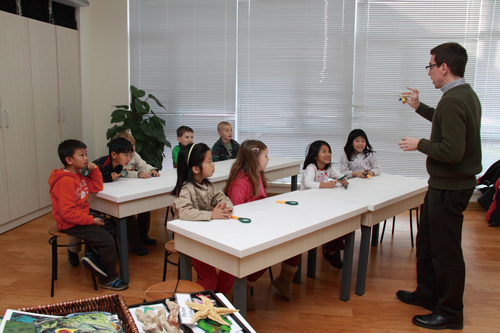
Montessori
The Montessori motto is “Help me do it by myself.” This approach is founded on the belief that every child should be respected as an individual and allowed to learn at his or her own pace within the prepared environment of a classroom. Montessori education fosters intelligent thinking, independence, self-esteem, problem-solving skills, and social aptitude.
Founder Dr. Maria Montessori (1870-1952) noticed that kids experienced “windows of opportunity” as they grew. She based the Montessori method on years of first-hand observations of students in the classroom. As the first woman to graduate from the University of Rome Medical School, Dr. Montessori brought a scientific approach to the field of education.
Famous alumni: Sergey Brin and Larry Page (co-founders of Google), Jimmy Wales (founder of Wikipedia), Dakota Fanning (actress)
Who does it target? Globally, Montessori schools vary widely in the age range of their students. They run the gamut from birth to adulthood (0-18 years), but the majority focus on early childhood education (1-6 years). Most of the institutions in Beijing fall into the latter category, but MSB and Daystar offer Montessori education for kids up to age 12.
How is it applied? Though there are several Montessori societies worldwide, the term “Montessori” itself isn’t trademarked. That’s why it’s crucial for parents to visit their child’s prospective school. The more prominent societies, like the American Montessori Society (AMS), formulate their own standards and accredit schools. In Beijing, MSB is the only AMS affiliate member.
An authentic Montessori classroom features multi-age groupings, uninterrupted blocks of work time, guided activity choices, and a range of specially designed learning materials. The curriculum focuses on five basic areas: practical life, sensorial, language, math, and culture. Kids progress from simple to complex tasks, all the while fulfilling their natural curiosity.
Montessori teachers direct and guide their students, rather than dictate. There are no numerical grades in Montessori. Instead, progress is tracked through observation, recordkeeping, and self-reflection. There is also no such thing as failure, since teachers present each child with a choice of work and a variety of difficulties.
Why should parents consider it? Many child experts agree that he most important period in a child’s development happens between birth and age 6. Dr. Montessori believed that kids at this age had an “absorbent” quality, like a sponge. The idea is that the proper guidance and stimulation will allow them to form patterns for the rest of their lives. In regular daycare, the focus is often on keeping young charges entertained. The Montessori classroom is designed to meet every child’s learning needs with special tools and materials. Students can set their own pace instead of being forced to do activities they don’t like. They become part of a multi-age community, with older kids playing the role of mentors and younger kids feeling supported for the challenges ahead.
Where is it offered?
Canadian International School of Beijing (CISB): 18 months-5 years
The Children’s House International Montessori Kindergarten: 1-6 years
Daystar Academy: 18 months-12 years
Eduwings Kindergarten: 1-6 years
Etonkids International Kindergarten: 1-6 years
The Family Learning House (TFLH): 18 months-6 years
House of Knowledge International Kindergarten (HoK): 10 months-6
years
International Montessori School of Beijing (MSB): 1-12 years
Mammolina Children’s Home – Montessori Kindergarten: 1-7 years
Positive Foundations School (PFS): 2-6 years
Ritz Calilord Academy: 18 months-6 years
How well does this education system prepare students for the real world? As self-directed learners, Montessori students gain transferrable skills that can be used throughout their lives. The core values are independence, self-esteem, and cooperation. Many Montessori schools in Beijing use a combination of educational approaches. For example, the core curriculum at MSB includes aspects of Montessori, the IB ’s Primary Years Programme and the British education system. Throughout the school’s 21 years of history, the majority of the students who stayed in Beijing went on to ISB. Other popular choices were WAB, YCIS Beijing, Harrow, DCB, and BSB.
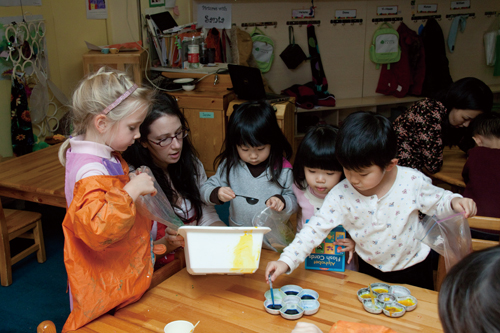
Multiple Intelligences
The theory of Multiple Intelligences (MI) was developed in 1983 by Dr. Howard Gardner, an education professor at Harvard University. He believed that the conventional notion of intelligence, based on IQ tests, didn’t look at the broader picture. In other words, MI doesn’t ask “How smart are you?” but rather “How are you smart?” In his groundbreaking book, Frames of Mind, Gardner came up with eight different intelligences:
Linguistic (word smart)
Logical-mathematical (number/reasoning smart)
Spatial (picture smart)
Bodily-kinesthetic (body smart)
Musical (music smart)
Interpersonal (people smart)
Intrapersonal (self smart)
Naturalist (nature smart)
Who does it target? All ages, from preschool to adult education.
How is it applied? MI is a “theory of intelligence … neither a specific educational method or approach.” There is no “right” way to apply it. That being said, the Multiple Intelligence Institute is an international organization dedicated to the promotion of MI theory in educational settings. It proposes three “keystone practices” of pluralization, mobilization, and personalization. Pluralization means giving children the opportunity to explore topics in a variety of ways and placing value on subjects beyond language and math. Mobilization means observing and recording children’s individual strengths, interests, and abilities. Personalization means translating students’ unique skills and interests into actual learning experiences.
In Beijing, the Ivy Schools (Ivy Academy, Ivy MI Kindergarten, and Ivy Bilingual School) are the only institutions in China to be accredited by the MI Institute.
Why should parents consider it? The MI theory values all students, academic subjects, and ways of learning. By going beyond the traditional focus on language and math, children are given the opportunity to discover their potential. MI theory can also inform parenting methods. As of January 18, the MI Institute offers an online introductory course on MI theory geared towards parents, caregivers, and other important people in a child’s life.
Where is it offered?
Ivy Academy: Ages 2-6 (English-only environment)
Ivy Bilingual School (IBS): Ages 2-6 (English/Chinese environment)
Ivy MI Kindergarten: Ages 4-5 (Chinese-only environment)
How well does this education system prepare students for the real world? MI educators would argue that multiple intelligences are the real world. By recognizing that each individual has different strengths, weaknesses, interests, and skills, and harnessing that knowledge in the classroom, teachers can help students reach their potential.
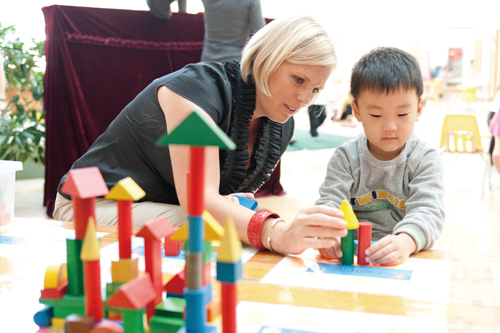
Reggio Emilia
Reggio Emilia is an approach to early childhood education named after the city of the same name in northern Italy, where communities in the surrounding villages sought a way to rebuild society after World War II. Under the leadership of founder and educator Loris Malaguzzi, Reggio Emilia evolved into a parent-led approach that spread all over the world. Malaguzzi believed that children learn through the “hundred languages” of words, movement, painting, drawing, sculpting, shadow play, music, theater, and more.
Reggio Emilia is all about relationships, including the child’s relationship with family, teachers, society, and their environment. This educational approach is self-guided; kids exert a degree of control over their own learning, learn about the world through all five senses, develop meaningful relationships with other children, and have the freedom to express themselves in various ways.
Who does it target? Reggio Emilia focuses on early childhood education (roughly ages 0-6).
How is it applied? Reggio Emilia does not have a governing organization, accreditation system, or set curriculum. According to the North American Reggio Emilia Alliance (NAREA), Reggio Emilia is a set of “community-constructed values that have been and are continuously being translated into high-quality early childhood practices.”
The main assessment method for Reggio Emilia is observation. Teachers track the child’s progress by collecting information over long time periods. This data includes photos, notes, videos, works of art, and conversations.
In Beijing, schools tend to combine Reggio Emilia with other educational approaches. House of Knowledge International Kindergarten has the strongest Reggio Emilia influence among schools in Beijing, but its curriculum also borrows aspects of Montessori and traditional Confucian theory. Though an IB World School, the Western Academy of Beijing’s early childhood center offers a Reggio Emilia-inspired program.
Why should parents consider it? Since Reggio Emilia revolves around family and community, parents are a crucial part of this approach. They’re considered the child’s first teacher, and are valued as partners, collaborators, and advocates for their kids. As a result, many parents extend the Reggio Emilia philosophy to the home.
Where is it offered?
House of Knowledge International Kindergarten (HoK): Ages 1-6
Western Academy of Beijing (WAB): Ages 3-4
How well does this education system prepare students for the real world? As in Montessori, Reggio Emilia seeks to develop skills for lifelong learning. Reggio children are able to step into a new curriculum or subject with the drive and competency to acquire knowledge. In class, students are not given any answers; instead, teachers prompt them with questions that allow them to form their own conclusions. Students apply their critical thinking skills and have the confidence to ask others for help.
Resources:
The College Board
Includes information on the AP program and SAT test fees, online registration, practice tests, and college applications.
www.collegeboard.org
UCAS
UCAS manages applications to universities in the UK. Prospective students can search for courses, look up tuition fees, and apply to colleges online.
www.ucas.com
IB Official Website
Includes information for parents, students, and educators, as well as a searchable database of IB World Schools.
www.ibo.org
Association Montessori Internationale
AMI was founded by Dr. Montessori to maintain the integrity of her life’s work.
www.montessori-ami.org
American Montessori Association
A US -based organization that offers Montessori resources and school accreditation.
www.amshq.org
Multiple Intelligence Institute
Dedicated to the understanding and application of MI theory in educational settings.
www.miinstitute.info
North American Reggio Emilia Alliance
NAREA is a US-based alliance for the promotion of Reggio Emilia in the classroom.
www.reggioalliance.org
Reggio Children
Home of the Centro Loris Malaguzzi non-profit organization founded by the municipality of Reggio Emilia.
www.reggiochildren.it
This article is excerpted from beijingkids 2012-2013 School Choice Guide. View it in PDF form here or contact distribution@beijing-kids.com to find out where you can pick up your free copy.



